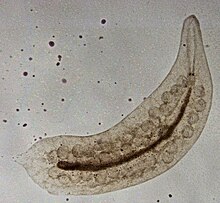Mesostoma ehrenbergii is a species of rhabdocoel flatworms in the family Typhloplanidae.[1]
| Mesostoma ehrenbergii | |
|---|---|

| |
| Live specimen | |
| Scientific classification | |
| Domain: | Eukaryota |
| Kingdom: | Animalia |
| Phylum: | Platyhelminthes |
| Order: | Rhabdocoela |
| Family: | Typhloplanidae |
| Genus: | Mesostoma |
| Species: | M. ehrenbergii
|
| Binomial name | |
| Mesostoma ehrenbergii (Focke, 1836)
| |
Description
editThe species is comparatively large for microturbellarians,[2] reaching 1,5 cm[3] in body length. Its body is highly transparent. It is dorsoventrally flattened with the anterior end gradually tapering and broadly pointed, and the posterior end sharply pointed.[4]
Taxonomy
editIt was described by Gustav Woldemar Focke as Planaria ehrenbergii in 1836.[1][5] The specific name references Christian Gottfried Ehrenberg.[5]
Distribution and habitat
editThe species has been recorded in Argentina, Brazil, Europe, Iran, Kenya, Kyrgyzstan, New Zealand, Peru, Siberia, Trinidad, and the USA.[1] It typically occurs in ponds and lakes.[2]
Ecology and behavior
editThe animal primarily feeds on cladocerans, but also on fairy shrimps, naidid oligochaetes, large rotifers and mosquito larvae. It is able to produce two types of eggs, subitaneous eggs and dormant eggs.[2]
References
edit- ^ a b c "Mesostoma ehrenbergii". Turbellarian taxonomic database. Retrieved 2021-05-14.
- ^ a b c Young, J. O. (2001). Keys to the freshwater microturbellarians of Britain and Ireland. Ambleside: Freshwater Biological Association. p. 87.
- ^ Noreña Janssen, C., Damborenea, C. & Brusa, F. (2016). Platyhelminthes: Rhabdocoela: Typhloplanidae. The Netherlands: Backhuys. p. 2.
{{cite book}}: CS1 maint: multiple names: authors list (link) - ^ Ferguson, F. F. & Hayes, W. T. Jr. (1941). "A Synopsis of the genus Mesostoma Ehrenberg 1835". Journal of the Elisha Mitchell Scientific Society. 57: 23.
{{cite journal}}: CS1 maint: multiple names: authors list (link) - ^ a b Focke, Gustav Woldemar (1836). "Planaria ehrenbergii" (PDF). Ann. Wien. Mus. 2: 191–206 – via ZOBODAT.